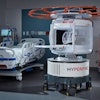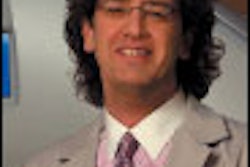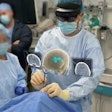Valued as a noninvasive imaging modality that is well-tolerated by patients, ultrasound has played an important role in breast imaging as an adjunct to conventional mammography, particularly for women with dense breasts.
Ultrasound helps clinicians determine whether a suspicious lesion is a cyst or a solid nodule, as well as whether these masses are malignant or benign. This ability to differentiate between cysts and solid nodules can not only save many women from undergoing unnecessary biopsies, but can alleviate their anxiety more quickly as well.
Ultrasound transducer technology has improved in the past two decades, making the modality a clear candidate for research and development of new technologies, according to Dr. Jay Baker, chief of radiology at Duke University Medical Center in Durham, NC.
"Fifteen years ago it was a 7-MHz transducer, and now we're up to 10 or 15," he said. "The higher the frequency, the better the resolution, and better resolution means breast imagers can see lesions with ultrasound that they couldn't see before."

"Better resolution means breast imagers can see lesions with ultrasound that they couldn't see before."
-- Dr. Jay Baker, Duke University Medical Center, Durham, NC
With this increased strength come new possibilities for ultrasound, and a variety of new techniques and technologies -- from elastography to compound imaging to ultrasound computer-aided detection (CAD) -- have appeared on the horizon. The hope is that as breast ultrasound continues to be developed, these technologies will offer new ways to add specificity to mammography, reduce biopsies, and even standardize ultrasound's use, therefore addressing its primary limitation, dependence on operator skill.
But the future isn't entirely rosy. There is an ongoing shortage of breast imagers, in part due to low levels of reimbursement and also because of legal fears, according to Dr. Thomas Stavros, chief of ultrasound and noninvasive vascular services with Radiology Imaging Associates and a long-time radiologist at Invision/Sally Jobe Breast Network, both in Denver. Ultrasound's reliance on operator skill is becoming a disadvantage, he believes.
"We don't have the (human) resources for handheld ultrasound," he said. "This shortage of personnel will almost certainly increase interest in automating the process."
"Buttonology": Boosting B-mode
Some of ultrasound's cutting edge may already exist as buttons on the console. One advanced technique, compound imaging, combines images from multiple lines of sight to create a single B-mode image. One of compound imaging's key benefits is that if what is being imaged is a real structure, it will show up on each line of sight and will be reinforced in the final image, while if what you're seeing is an artifact, it will only show up on one line of sight and will be therefore be less evident in the final picture.
"Compound imaging is a way of reinforcing real information, real structures," Baker said.
But compound imaging can also make useful information more difficult to interpret, he cautioned. When an ultrasound beam is attenuated so that it can't pass through a mass, the image reflects this with a shadow behind the mass, which can help doctors recognize a potential cancer. Similarly, ultrasound images of cysts tend to have a bright band behind the cyst. Compound imaging can make both of these effects less obvious, making it more difficult to identify what's actually being imaged. One solution is to scan twice, once without compound imaging and again with it to be able to see the contrast better, according to Baker.
Color and power Doppler can be useful for looking at blood flow; some researchers have found that there are vascular differences between cancerous and healthy tissue. Doppler imaging can also be used with contrast agents, but it remains unclear as to whether this combination is necessary or effective in breast imaging.
Some researchers have used Doppler imaging with contrast and have found breast lesions that originally seemed avascular (when imaged without contrast), but later proved to be vascular, according to a review article on breast ultrasound authored by Chandra Seghal, Ph.D., director of ultrasound research at the Hospital of the University of Pennsylvania in Philadelphia (Journal of Mammary Gland Biology and Neoplasia, November 2006, Vol. 11, pp. 113-123).
With another advanced imaging technique, tissue harmonic imaging, the ultrasound scanner "listens" for multiples of the fundamental frequency, which give more image data and can reduce artifacts, therefore improving resolution. Since lower frequencies penetrate deeper into the body, what the sonographer "hears" back from a scan with harmonic imaging is the higher frequencies of the sound waves. Harmonic imaging's usefulness is limited in breast imaging, Baker said. "Since we're not penetrating all that deeply anyway, high-frequency transducers can penetrate the tissue deeply enough without the additional boost from harmonic imaging."
Tissue elasticity imaging: Finding marbles in Jell-O
The techniques described above improve image quality of breast ultrasound. But tissue elasticity imaging, or elastography, adds a whole new dimension, according to Dr. Richard Barr, Ph.D., professor of radiology at Northeastern Ohio Universities College of Medicine in Rootstown, OH. Elastography measures the relative stiffness of tissue caught in the ultrasound frame via mild tissue compression (the woman's respiration usually creates enough compression to produce an elastographic image; if more compression is needed, the sonographer can apply gentle palpation with the transducer).
If the breast imager finds a well-defined lesion in the B-mode image, elastography can help determine whether a mass is benign or malignant. Elastography also seems to show promise in detecting lobular cancers, which are characterized by cancer cells that grow in fine lines that can be palpated but are often missed on x-ray-based mammography or B-mode ultrasound.
"Think of a marble in Jell-O -- if you compress the Jell-O, it deforms, but the marble doesn't," Barr said. "Elastography applies grayscale to the changes in hardness between healthy and cancerous tissue -- on our system, soft tissue is lighter and lesions are darker -- and can determine whether something is malignant or benign."
At the 2006 RSNA conference in Chicago, Barr and his colleagues presented results from a study they believe shows that elastography could decrease the number of biopsies performed on BI-RADS 3 lesions and could change the status of BI-RADS 4 lesions to "close follow-up" rather than "go directly to biopsy." Their study found that elastography was able to locate metastatic disease.
Barr and his colleagues also noticed that malignant lesions appeared three to four times their size than in the B-mode image when elastography was applied. Could it be that more aggressive tumors have more dramatic size changes?
"We're trying to design some studies that will perform detailed histological evaluations so we can decipher what's really going on," Barr said.
One of elastography's limitations is that the breast imager has to get a well-defined image of a lesion in B-mode before elastography will be helpful or accurate, since the technique is based on the relative stiffness of tissues. Some ultrasound vendors have included in their device software a feature that "veils" the image on the computer display if the sonographer is not in the right place, so that the image won't be used.
"Obviously, if the person scanning doesn't notice that he or she has missed the lesion, applying elastography won't be effective," Barr said.
Whether elastography evolves into a routinely used clinical tool depends on if the technique can help doctors decide whether masses should be biopsied or not. If the technology could be quantified enough so that ranges of tissue hardness could be assigned a numerical value, it could offer more data as to whether a lesion should be investigated further.
CAD: Can breast ultrasound be quantified?
As CAD technology has become widely used with mammography and increasingly accepted with MRI, interest in pairing it with ultrasound has also spread.
"Ultrasound CAD is in its infancy right now and emphasizes computer-assisted diagnosis," said Dr. Wendie Berg, Ph.D., head of the American College of Radiology Imaging Network (ACRIN 6666) multicenter trial that is evaluating whole-breast ultrasound for breast cancer screening. "And the fact is, in breast ultrasound, detection is usually a greater challenge than interpretation."
Some studies have posited that a lack of real-time analysis has made the adoption of ultrasound CAD difficult; studies of ultrasound CAD have used static images that are then analyzed.

"Breast imaging is not totally a science, but an art."
-- Dr. Stamatia Destounis, University of Rochester/Elizabeth Wende Breast Imaging Center, Rochester, NY
"Each radiologist may classify lesions a bit differently," she said. "When we do reader studies, invariably there are differences between individuals as to where the lesion is marked. Breast imaging is not totally a science, but an art."
Despite its limitations, breast ultrasound offers real benefit, particularly for women with dense breasts -- the very women who need extra technological support in diagnosis and screening. The possibility of catching early cancers in at-risk women may prove more compelling than the possibility of increased false positives, according to Berg.
"With the high rate of so-called interval cancers in women with dense breasts -- cancers that show up before the next screening exam -- we really need to be doing something more than we currently are," she said.
Ultrasound's mix of low cost, noninvasive nature, and rapidly improving image quality means it will continue to play a role as the primary adjunctive imaging modality to mammography for years to come.
By Kate Madden Yee
AuntMinnie.com contributing writer
March 1, 2007
Copyright © 2007 AuntMinnie.com




















